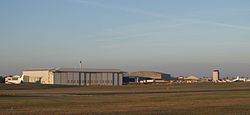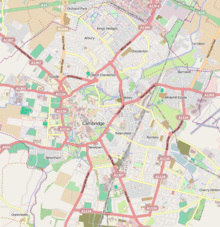Cambridge Airport facts for kids
Quick facts for kids
Cambridge International Airport
|
|||||||||||
|---|---|---|---|---|---|---|---|---|---|---|---|
 |
|||||||||||
| Summary | |||||||||||
| Airport type | Public | ||||||||||
| Operator | Marshall Aerospace | ||||||||||
| Serves | Cambridge | ||||||||||
| Location | Cambridge and Teversham, Cambridgeshire | ||||||||||
| Elevation AMSL | 47 ft / 15 m | ||||||||||
| Coordinates | 52°12′18″N 000°10′30″E / 52.20500°N 0.17500°E | ||||||||||
| Website | cambridgeairport.com | ||||||||||
| Map | |||||||||||
| Runway | |||||||||||
|
|||||||||||
| Statistics | |||||||||||
|
|||||||||||
Cambridge Airport (IATA: CBG, ICAO: EGSC) is a small airport in South Cambridgeshire, England. It used to be called Marshall Airport Cambridge UK. The airport is located on the eastern side of Cambridge, near the village of Teversham. It is about 1.5 miles (2.4 km) from the centre of Cambridge and about 50 miles (80 km) from London.
The airport first opened in 1938. It took the place of an older airfield at Fen Ditton. Marshall Aerospace, a company based in Cambridge, owns and runs the airport. This company has a long history of working on planes for both everyday use and for the military. The main airport building was designed by an architect named Harold Tomlinson in 1936–37. For many years, the Cambridge University Air Squadron was based here.
Marshall of Cambridge Aerospace Limited has a special licence from the CAA. This licence, called a Public Use Aerodrome Licence (Number P433), means the airport can have public passenger flights. It also allows flights for training new pilots. There are four flying schools at the airport. It is also used for private planes and business flights.
In October 2008, the airport's name changed from Cambridge City Airport to Marshall Airport Cambridge UK. This happened when a new business centre for planes was opened. In 2011, Cambridge Airport became separate from Marshall. It hired a new director and changed its name back to Cambridge Airport. The airport wants to become an important "hub" (a central airport) for the east of England. The passenger building is being updated to make it better for travellers.
The Future of Cambridge Airport
Land in Cambridge is very expensive. There are also large areas of "green belt" land around the city. This means new houses cannot be built there. Because of this, people suggested moving the airport in 2000. Moving it would free up about 500 acres (200 hectares) of land. This land could then be used to build thousands of new homes. Cambridgeshire County Council studied the idea of a new airport. They asked for permission to plan it, but later changed their minds.
Since then, Marshall Aerospace has continued to improve the airport site. In autumn 2008, new buildings for aviation companies were opened. These included a new hangar (a large building for planes) that is about 20,000 square feet (1,900 m²) in size. This added to the 1,200,000 square feet (110,000 m²) of hangar space already there.
In April 2010, Marshall Aerospace said it would not move Cambridge Airport. They decided not to move it to make space for new housing. Other places like RAF Mildenhall and RAF Wyton were considered. But Marshall decided that none of these places were good enough to move the airport to.
In January 2011, Cambridge Airport became independent from Marshall. It then shared its plans for the airport's future. The airport planned to have international flights for the London 2012 Olympic Games. For 2012, the airport started new international holiday flights to Europe. It also added regular flights to the Channel Islands. The passenger terminal is being fully updated. This will make services better and more convenient for passengers. The airport plans to add flights to more places important for business and holidays.
Airlines and Destinations
| Airlines | Destinations |
|---|---|
| Blue Islands | Jersey |
| Small Planet Airlines | Seasonal: Verona |
| Danube Wings | Seasonal: Dole-Jura [begins 30 June 2012] |
Images for kids




